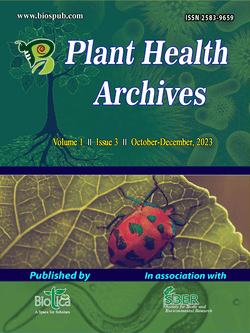
Current Status and Future Strategies of Microbial Control of Fungal Diseases of Forest Trees
Pranab Dutta*
College of Agriculture, Central Agricultural University (Imphal), Kyrdemkulai, Ri Bhoi Meghalaya (793 105), India
Madhusmita Mahanta
College of Post Graduate Studies in Agricultural Sciences, Central Agricultural University (Imphal), Umiam, Meghalaya (793 103), India
Samaritan Dutta
ADAC&RI, Tamil Nadu Agricultural University, Navalurkottapattu, Tamil Nadu (620 027), India
DOI: https://doi.org/10.54083/PHA/1.3.2023/130-138
Keywords: Disease management, Forest disease, Formulation, Microbial control
Abstract
Microbial control is one of the potential alternatives of chemical pesticides for plant disease management. Microbes like fungus, bacteria, virus, nematode etc. as bio-agent is widely exploited during the last two decades. However, inconsistency in their field performance is a matter of great concern and proving to be a major bottleneck in their large-scale application. These agents are capable of replicating in the environment, but require certain frequent manipulations to get activated/ multiplied after its application. Formulation for easy field application is its major requirement for optimization of its efficacy, stability and ease of application. Formulation is available in the form of water dispersible powder, granule, emulsion, etc. with carriers, diluents and surface-active agents, according to need of a final consumer product. Amongst different application methods seed treatment is found to be the best method in combating disease management as it protect the crop from both seed and soil borne pathogen.
Downloads
not found
Reference
Anonymous, 1999. Guidelines/data requirement for registration of bio-pesticides. Directorate of Plant Protection, Quarantine and Storage. Ministry of Agriculture. Government of India. Available at: https://ppqs.gov.in/. Accessed on: February 25, 2023.
Baby, U.I., Manibhushanarao, K., 1996. Fungal antagonists and VA mycorrhizal fungi for biocontrol of Rhizoctonia solani, rice sheath blight pathogen. In: Recent Developments in Biocontrol of Plant Pathogens. (Eds.) Manibhushanarao, K. and Mahadevan, A. Today and Tomorrow's Printers and Publishers, New Delhi. pp. 1-9.
Das, B.C., Dutta, P., 1999. Biological management of stem rot of soybean caused by Rhizoctonia solani Kuhn. Journal of Agricultural Science Society for North East India 12(2), 217-220.
De, R.K., Mukhopadhyay, A.N., 1994. Biological control of tomato damping-off with Gliocladium virens. Journal of Biological Control 8(1), 34-40. DOI: 10.18311/jbc/1994/15110.
Dutta, P., Das, B.C., 1999a. Control of Rhizoctonia solani in Soybean (Glysine max) by farm yard manure culture of Trichoderma harzianum. The Indian Journal of Agricultural Sciences 69(8), 596-598.
Dutta, P., Das, B.C., 1999b. Effect of seed pelleting and soil application of Trichoderma harzianum in the management of stem rot of soybean. Journal of Mycology and Plant Pathology 29(3), 317-322.
Economidis, I., Kessler, C., 2004. Safe or Unsafe? 15 Years of EU Risk Assessment Research on GMOs. Chapter 52, Part 9: Risk Assessment of Transgenic Crops. In: Handbook of Plant Biotechnology. (Eds.) Christou, P. and Klee, H. John Wiley & Sons, Ltd. DOI: 10.1002/0470869143.kc054.
Jeyaratnam, J., 1990. Acute pesticide poisoning: A major global health problem. World Health Statistics Quarterly 43(3), 139-144.
Kumar, S., Thakur, M., Rani, A., 2014. Trichoderma: Mass production, formulation, quality control, delivery and its scope in commercialization in India for the management of plant diseases. African Journal of Agricultural Research 9(53), 3838-3852. DOI: 10.5897/AJAR2014.9061.
Lal, J.B., 1989. India’s Forests: Myths and Reality. Nataraj Publishers, Dehradun. pp. 1-304.
Mishra, D.S., 2002. Development of mixed formulation of fungal (Trichoderma) and bacterial (pseudomonas) biocontrol agents for management of plant diseases. PhD Thesis, G.B. Pant University of Agriculture and Technology, Pantnagar (U.S. Nagar), Uttaranchal (263 145), India.
Mukherjee, P.K., Mukhopadhyay, A.N., 1995. In situ mycoparasitism of Gliocladium virens on Rhizoctonia solani. Indian Phytopathology 48(1), 101-102.
Mukhopadhyay, A.N., 1994. Biocontrol of soil borne fungal plant pathogens: Current status, future prospects and potential. Indian Phytopathology 47(2), 119-126.
Singh, U.S., Mishra, D.S., Zaidi, N.W., Varshney, S., Sharma, R., Singh, N., 2005. Potential and effectiveness of fungi and bacteria as biocontrol agents for plant disease management. In: Integrated Pest Management: Principles and Applications. Volume 1. (Eds.) Singh, A., Sharma, O.P. and Garg, D.K. CBS Publishers, New Delhi.
Subramanian, S., Santharam, G., Sathiah, N., Kennedy, J.S., Rabindra, R.J., 2006. Influence of incubation temperature on productivity and quality of Spodoptera litura nucleopolyhedrovirus. Biological Control 37(3), 367-374. DOI: 10.1016/j.biocontrol.2006.01.011.
Upamanya, G.K., Bhattacharyya, A., Dutta, P., 2020. Consortia of entomo-pathogenic fungi and bio-control agents improve the agro-ecological conditions for brinjal cultivation of Assam. 3 Biotech 10, 450. DOI: 10.1007/s13205-020-02439-3.
